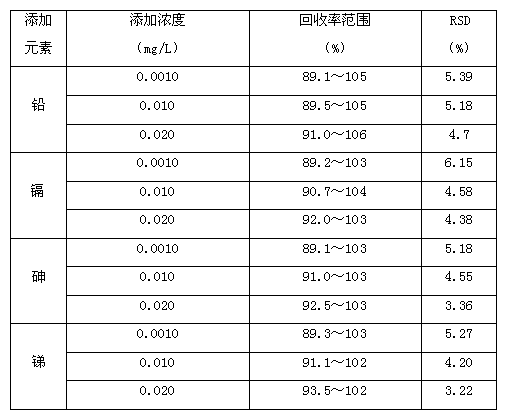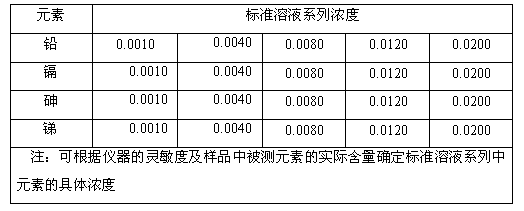Detection method for determining migration quantity of trace lead, cadmium, arsenic and antimony in food contact material by sequential injection-HG-AFS method
A-HG-AFS, food contact material technology, applied in the field of detection of the migration of harmful elements in food contact materials, can solve the problems of expensive instruments, low sensitivity, unreachable sensitivity, etc.
- Summary
- Abstract
- Description
- Claims
- Application Information
AI Technical Summary
Problems solved by technology
Method used
Image
Examples
Embodiment Construction
[0034] A detailed description will be given below of specific embodiments of the present invention.
[0035] The method for detecting the migration of harmful elements in food contact materials by sequential injection-hydride generation-atomic fluorescence spectrometry of the present invention comprises the following steps:
[0036] 1. Sample pretreatment method
[0037] 1. Migration test
[0038] 1. 1 Tableware containers made of ceramics, enamel, and glass
[0039] Wash and dry the sample first, then add 4% acetic acid to boil to 1cm from the upper edge, add a glass cover, and place it at 22°C±2°C for 24h for migration test. After thorough mixing, take part of the migration test solution for analysis.
[0040] 1. 2 Stainless steel and aluminum tableware containers
[0041] Wash and dry the sample first, then add 4% acetic acid to 0.5cm from the upper edge, add a glass cover, boil on low heat for 30 minutes, take it off, add 4% acetic acid to the original volume, and p...
PUM
 Login to View More
Login to View More Abstract
Description
Claims
Application Information
 Login to View More
Login to View More - R&D
- Intellectual Property
- Life Sciences
- Materials
- Tech Scout
- Unparalleled Data Quality
- Higher Quality Content
- 60% Fewer Hallucinations
Browse by: Latest US Patents, China's latest patents, Technical Efficacy Thesaurus, Application Domain, Technology Topic, Popular Technical Reports.
© 2025 PatSnap. All rights reserved.Legal|Privacy policy|Modern Slavery Act Transparency Statement|Sitemap|About US| Contact US: help@patsnap.com


